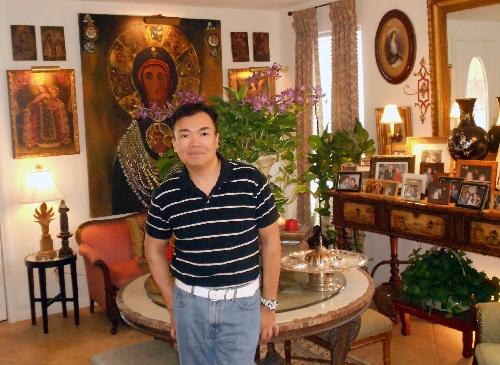Myriad ancient artifacts took a lifetime to collect for Las Vegas resident
Life-size paintings of unfamiliar faces stretch from floor to ceiling across walls filled with other art on every surface. Colorful metal vases block what's supposed to be a small window between rooms. Stone sculptures adorn a table down the hall from rooms of white-and-blue dishes displayed on a dozen shelves.
One might think the southwest Las Vegas property is merely a storage unit for meaningless junk.
A house used as a stockpile, maybe. For worthless trash -- not quite.
The paintings: ancient art, including a portrait of a Spanish bishop on nearly petrified canvas from 1702. The vases: Chinese temple jars from a forbidden city. The sculptures: centuries-old, hand-carved religious statues. The dishes: precious porcelain excavated from around the globe.
And the home is just one host to the hundreds of artifacts that fashion designer David Tupaz collects. He started renting the property last year so he could unveil what had been stuck in storage after his 3,500-square-foot home in Los Angeles could no longer fit any more.
The Chinese-Filipino man said he's drawn to porcelain because the precious dishes were used in China before becoming a popular fabric of European society. His oldest set comes from the Tang Dynasty in the seventh century. The traditional white pieces were excavated from sunken ships, while the darker dishes are stained from soil after being buried with the dead in Xian, China.
Las Vegas has quickly become more than a display case, though, as Tupaz is determined to start the fashion industry in a glamorous entertainment capital that he says should already have one.
He gave an embarrassed laugh at GQ's recent worst-dressed list, which ranked Las Vegas at 13.
"I told people I bought a house in Vegas. They said, 'Vegas! It's like Walmart and Target town,' " Tupaz said. "I want that to change."
He lives in his 2,600-square-foot home every other week while preparing for his local September fashion show and guest speaking at design schools.
Where old relics don't plaster a surface, it's instead pictures of old friends -- Princess Diana, Barb ra Streisand, Elizabeth Taylor, the Reagans, the Kardashians -- the list could go on forever. The names mark his notoriety in the business to which he adds, "I'm not as famous as Calvin Klein, but famous people know me. And that's famous enough."
Although his sense in high fashion and interest in antique artifacts may seem centuries apart, Tupaz admits the two are one in the same. Thumbing through the racks of his couture is as if the hangers are a book's pages and the clothing a historic print.
Propped behind a glass case, pictures of the Russian Imperial Family sit not far from remnants of a Tupaz fashion show that featured styled ushankas, or the fur hats that became popular in that country circa 1920. His latest collection will debut a long red coat with chunky stripes of black and white collected at a cuffed sleeve. A bow and tailored fit gives the Civil War-inspired outfit Tupaz's signature feminine feel.
"Fashion is the only factor that identifies every culture throughout the centuries," Tupaz said. "It is fashion, not their faces, that we identify who and where someone is from. It tells culture, race and wealth. The history of costume tells you how human beings have progressed."
He also uses materials from the past as part of his work with the nonprofit organization Repurpose America. Tupaz uses the group's materials, such as vinyl banners from conventions, to make clothing and purses. Then a portion of the sales goes back to the nonprofit.
Tupaz's interest in history was passed down from his grandfather, who constantly collected art and artifacts through the years. He inherited part of those heirlooms, including a unique porcelain baby Buddha that was already considered an antique when his grandfather purchased it in the '40s in Shanghai.
"My field trips weren't Disneyland -- they were museums," said Tupaz, who started saving his money to buy thrifted porcelain cups and saucers in the seventh grade.
He first started collecting pictures of saints at age 9, his mother Sally Tupaz said, laughing at the fact that she thought her son wanted to be a priest.
"All his allowance went to collecting," she said.
Of his pieces, he calls the older the better -- he is fascinated with the time some relics have been preserved.
Tupaz transports the tokens between his homes, so like fashion, his palaces change every season.
Contact Southwest and Spring Valley View reporter Jessica Fryman at jfryman@viewnews.com or 380-4535.



















